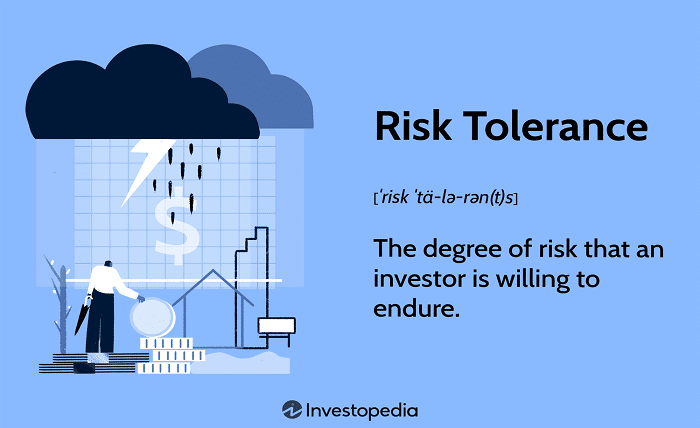Risk Tolerance: A Comprehensive Guide for Investors

Introduction
Risk tolerance is a fundamental concept in the world of investing. It refers to an investor’s ability and willingness to endure fluctuations in the value of their investments. Understanding risk tolerance is crucial for developing an investment strategy that aligns with one’s financial goals and comfort level. This guide will delve deep into what risk tolerance is, how to assess it, and why it matters in achieving long-term financial success.
What is Risk Tolerance?
Risk tolerance is the degree of variability in investment returns that an individual is willing to withstand. Investors with high risk tolerance are comfortable with potential losses in the short term for the possibility of higher long-term gains. Conversely, those with low risk tolerance prefer more stable investments, even if it means lower returns. Assessing risk tolerance helps investors make informed decisions that align with their financial goals and emotional comfort.
Factors Influencing Risk Tolerance
Several factors influence an individual’s risk tolerance, including age, income, financial goals, investment knowledge, and personality. Younger investors might have higher risk tolerance due to a longer investment horizon, while those nearing retirement typically prefer lower risk. Understanding these factors can help tailor an investment strategy that suits one’s risk tolerance.
Assessing Your Risk Tolerance
Assessing risk tolerance involves evaluating both the ability and willingness to take risks. Financial advisors often use questionnaires to gauge an investor’s comfort with risk. These assessments consider factors like investment time horizon, financial situation, and past experiences with investing. A thorough assessment ensures that your investment strategy aligns with your risk tolerance.
Types of Risk Tolerance
Risk tolerance can be categorized into three types: aggressive, moderate, and conservative. Aggressive investors are willing to take high risks for potentially higher returns. Moderate investors seek a balance between risk and reward, while conservative investors prioritize capital preservation over growth. Identifying your type helps in building a suitable investment portfolio.
Importance of Risk Tolerance in Investing
Risk tolerance plays a crucial role in investment planning. An investment strategy that matches your risk tolerance can help avoid emotional decisions during market volatility. It ensures that you stay invested during market downturns and benefit from long-term growth. Understanding risk tolerance is key to maintaining financial discipline and achieving investment goals.
Aligning Investments with Risk Tolerance
Aligning investments with risk tolerance involves selecting assets that match your comfort level with risk. Aggressive investors might opt for stocks and high-yield bonds, while conservative investors might prefer bonds and dividend-paying stocks. A diversified portfolio that reflects your risk tolerance can help manage market volatility and achieve steady returns.
Adjusting Risk Tolerance Over Time
Risk tolerance is not static and can change over time due to various factors such as life events, changes in financial situation, or shifts in market conditions. Regularly reassessing your risk tolerance ensures that your investment strategy remains aligned with your current financial goals and comfort level. Adjusting your portfolio as needed helps in maintaining a balanced approach to risk.
The Role of Financial Advisors in Risk Tolerance
Financial advisors play a vital role in helping investors assess and manage their risk tolerance. They provide valuable insights and personalized advice based on an individual’s financial situation and investment goals. A good financial advisor can help create a diversified portfolio that matches your risk tolerance and provides guidance during market fluctuations.
Risk Tolerance and Asset Allocation
Asset allocation is the process of dividing an investment portfolio among different asset categories, such as stocks, bonds, and cash. Risk tolerance is a critical factor in determining the appropriate asset allocation. Investors with high risk tolerance might have a higher allocation to stocks, while those with low risk tolerance might favor bonds and cash. Proper asset allocation can help manage risk and achieve investment objectives.
Common Mistakes in Assessing Risk Tolerance
Common mistakes in assessing risk tolerance include overestimating one’s ability to handle risk, ignoring the impact of market volatility, and failing to consider long-term financial goals. These mistakes can lead to an unsuitable investment strategy and potential financial losses. Avoiding these pitfalls requires a realistic assessment of your risk tolerance and a disciplined approach to investing.
Tools and Resources for Evaluating Risk Tolerance
There are several tools and resources available to help investors evaluate their risk tolerance. Online questionnaires, financial planning software, and consultations with financial advisors can provide valuable insights. Utilizing these resources ensures a thorough understanding of your risk tolerance and aids in developing a suitable investment strategy.
Conclusion
Risk tolerance is essential for successful investing. By assessing your risk tolerance, aligning your investments accordingly, and regularly reassessing your strategy, you can navigate market volatility and achieve your financial goals. With the right approach, risk tolerance becomes a powerful tool in building a resilient and profitable investment portfolio.
FAQs
1. What is risk tolerance?
Risk tolerance is the degree of variability in investment returns that an individual is willing to endure, balancing the potential for loss against the possibility of gains.
2. How do I assess my risk tolerance?
Assessing risk tolerance involves evaluating your financial situation, investment goals, and emotional comfort with risk, often through questionnaires or financial advisor consultations.
3. Why is risk tolerance important in investing?
Risk tolerance is crucial because it helps in creating an investment strategy that aligns with your financial goals and emotional comfort, preventing hasty decisions during market fluctuations.
4. Can my risk tolerance change over time?
Yes, risk tolerance can change due to life events, financial situation changes, and market conditions. Regularly reassessing ensures your investment strategy remains aligned with your current goals.
5. How does risk tolerance affect asset allocation?
Risk tolerance influences asset allocation by determining the mix of investments in your portfolio. Higher risk tolerance might mean more stocks, while lower risk tolerance might favor bonds and cash.





